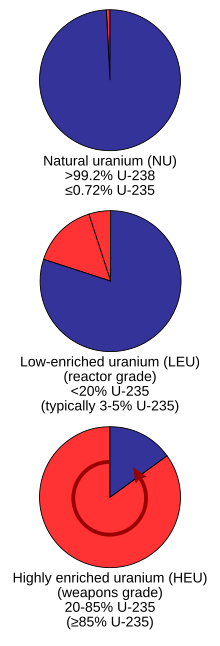
Back يورانيوم مخصب Arabic Обогатен уран Bulgarian Urani enriquit Catalan Obohacený uran Czech Hochangereichertes Uran German Riĉigita uranio Esperanto Uranio aberastu Basque غنیسازی اورانیوم Persian Uranio enriquecido Galician אורניום מועשר HE
Enriched uranium is a type of uranium in which the percent composition of uranium-235 (written 235U) has been increased through the process of isotope separation. Naturally occurring uranium is composed of three major isotopes: uranium-238 (238U with 99.2739–99.2752% natural abundance), uranium-235 (235U, 0.7198–0.7202%), and uranium-234 (234U, 0.0050–0.0059%).[citation needed] 235U is the only nuclide existing in nature (in any appreciable amount) that is fissile with thermal neutrons.[1]

Enriched uranium is a critical component for both civil nuclear power generation and military nuclear weapons. The International Atomic Energy Agency attempts to monitor and control enriched uranium supplies and processes in its efforts to ensure nuclear power generation safety and curb nuclear weapons proliferation.
There are about 2,000 tonnes of highly enriched uranium in the world,[2] produced mostly for nuclear power, nuclear weapons, naval propulsion, and smaller quantities for research reactors.
The 238U remaining after enrichment is known as depleted uranium (DU), and is considerably less radioactive than even natural uranium, though still very dense. Depleted uranium is used as a radiation shielding material and for armor-penetrating weapons.
- ^ OECD Nuclear Energy Agency (2003). Nuclear Energy Today. OECD Publishing. p. 25. ISBN 9789264103283.
- ^ Cochran (Natural Resources Defense Council), Thomas B. (12 June 1997). "Safeguarding Nuclear Weapon-Usable Materials in Russia" (PDF). Proceedings of international forum on illegal nuclear traffic. Archived from the original (PDF) on 22 July 2012.
© MMXXIII Rich X Search. We shall prevail. All rights reserved. Rich X Search